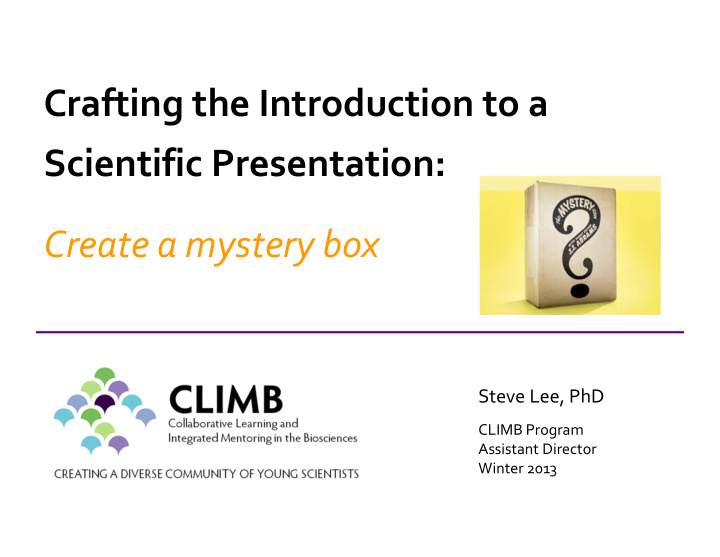



Crafting the Introduction to a Scientific Presentation: Create a mystery box Steve Lee, PhD CLIMB Program Assistant Director Winter 2013
Our CLIMB curriculum of workshops on communication in scientific research: 1) Delivering scientific presentations and posters for impact: Make it stick with SUCCESs 2) Crafting the introduction to a scientific presentation: Create a mystery box 3) Communicating and collaborating across disciplines: Use simple words 4) Displaying visual evidence in scientific presentations: Help viewers make valid scientific decisions 2
Why are we focusing on a 10-minute presentation to a broad audience? ● to stretch your communication skills with a tough challenge: ○ to explain your research concisely and ○ to engage a broad audience ● to help you collaborate across your fields ● to provide a brief presentation for all to practice 3
How do you set up your intro? The traditional introduction is boring ● background ○ full of acronyms and jargon ○ definitions (maybe) ● question ● hypothesis This is dry and does not engage the audience. 4
Instead, set up a scientific story for your introduction ● A story helps to connect with a broad audience ○ they won’t be familiar with the context and jargon ● Set up a scientific story by creating a mystery box ○ Let’s view JJ Abram’s TED talk 5
How do you create a mystery box? ● help your audience to imagine ○ ex: a major problem will be solved with this new instrument ● explain why your research is significant ○ ex: the disease affects millions of people ● describe why your research is so fascinating ○ a unique or counter-intuitive research puzzle 6
Remember to address the Curse of Knowledge : make your ideas stick with SUCCESs S imple: find and share the core message U nexpected: get their attention – surprise or twist C oncrete: help people understand – be specific C redible: help people believe – give evidence E motional: help people to care – inspire S tories: share ideas to simulate and inspire 7
Communicate to inform and inspire Inform Inspire ○ concrete information ○ significance ○ visual and audio info ○ stories & analogies ○ details; raw data ○ cast a vision for future ○ credible evidence ○ big picture But, if you only inform, But, if you only inspire, your talk may be: your talk may be: ○ dry or flat ○ vague ○ random details ○ ambiguous ○ lack meaning ○ not concrete 8
The challenge is to go broad and deep speak to broad audiences: use analogies and illustrations speak deeply: use 1 or 2 examples for the experts 9
For slides: pay attention to these details ● plan for 1-2 min/slide ○ for 10-min talk: 5-8 slides ● maximize the “info to ink” ratio ● don’t use serif fonts (e.g. ��������������� ) ● convert bullet lists into word tables (if possible) ● use message or question titles 10
Practice and get feedback ● pay attention to your physical stance ○ your posture affects your audience’s perception of you ○ and your performance as well ● View Amy Cuddy’s Poptech talk ● connect your spoken words with slides ● get feedback early and often 11
Your first practice: set up your intro ● select a research project with some results ● present your intro (few slides) ● explain up to your question and hypothesis Scheduling ● Winter ○ Part 1: intro Quarter ○ Part 2: intro + design and methods ● Spring ○ Part 3: full presentations (videotaped) Quarter ○ individual mtgs for feedback 12
Recommend
More recommend